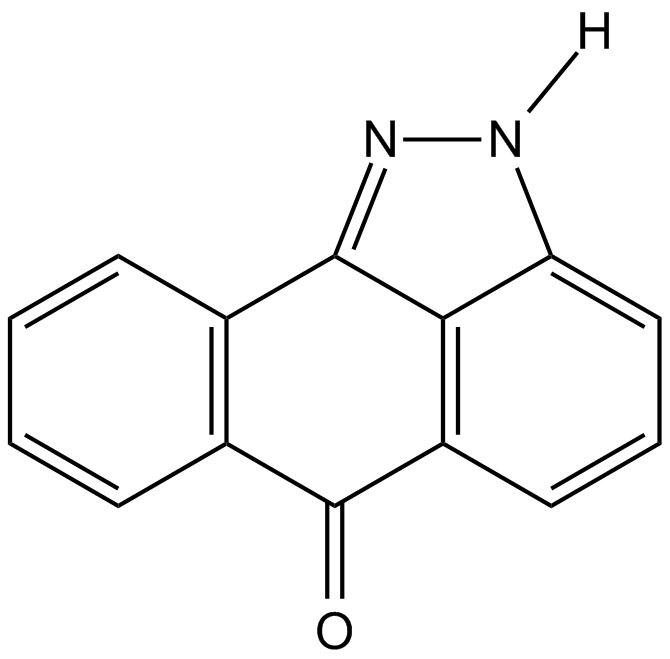SP600125
| Code | Size | Price |
|---|
| AG-CR1-3549-M001 | 1 mg | £30.00 |
Quantity:
| AG-CR1-3549-M005 | 5 mg | £60.00 |
Quantity:
Prices exclude any Taxes / VAT
Overview
Regulatory Status: RUO
Shipping:
AMBIENT
Storage:
Short term storage:+4°C. Long term storage:-20°C.
Images
Documents
Further Information
Alternate Names/Synonyms:
Anthra[1-9-cd]pyrazol-6(2H)-one; 1,9-Pyrazoloanthrone; Pyrazolanthrone; NSC 75890
Appearance:
White to off-white solid.
CAS:
129-56-6
EClass:
32160000
Form (Short):
solid
Handling Advice:
Protect from light when in solution.
InChi:
InChI=1S/C14H8N2O/c17-14-9-5-2-1-4-8(9)13-12-10(14)6-3-7-11(12)15-16-13/h1-7H,(H,15,16)
InChiKey:
ACPOUJIDANTYHO-UHFFFAOYSA-N
Long Description:
Chemical. CAS: 129-56-6. Formula: C14H8N2O. MW: 220.2. SP600125 is an orally active, reversible and ATP-competitive broad-spectrum JNK inhibitor for JNK1, JNK2 and JNK3 (IC50 = 40nM, 40nM and 90nM, respectively). In Jurkat T cells, SP600125 suppressed the phosphorylation of c-Jun with IC50 of 5-10 uM. It has 10-fold greater selectivity against MKK4, 25-fold greater selectivity against MKK3, MKK6, PKB and PKCalpha, and 100-fold selectivity against ERK2, p38, Chk1, EGFR. SP600125 is also a broad-spectrum inhibitor of serine/threonine kinases including hydrocarbon receptor (AhR), Mps1, Aurora kinase A, FLT3 and TRKA. SP600125 inhibits cell cycle, autophagy and ferroptosis and activates apoptosis. It shows anti-inflammatory activity by inhibiting the expression of inflammatory genes such as COX-2, IL-2 IFN-gamma and TNF-alpha and has antiviral and neuroprotective properties. SP600125 demonstrated inhibitory effects on tumor cell proliferation, endothelial cell migration and tumor growth as well as blocking tumor and endothelial cells in the G2 phase of the cell cycle. SP600125 also promotes adipogenesis from MSCs and is an essential component of media for maintaining stem cells in naive pluripotent state. JNK1-mediated NLRP3 phosphorylation at S194 is a critical priming event and is essential for NLRP3 inflammasome activation. The JNK1 inhibitor SP600125 exhibits a robust inhibition of inflammasome activation.
MDL:
MFCD00022289
Molecular Formula:
C14H8N2O
Molecular Weight:
220.2
Package Type:
Vial
Product Description:
SP600125 is an orally active, reversible and ATP-competitive broad-spectrum JNK inhibitor for JNK1, JNK2 and JNK3 (IC50 = 40nM, 40nM and 90nM, respectively). In Jurkat T cells, SP600125 suppressed the phosphorylation of c-Jun with IC50 of 5-10 uM. It has 10-fold greater selectivity against MKK4, 25-fold greater selectivity against MKK3, MKK6, PKB and PKCalpha, and 100-fold selectivity against ERK2, p38, Chk1, EGFR. SP600125 is also a broad-spectrum inhibitor of serine/threonine kinases including hydrocarbon receptor (AhR), Mps1, Aurora kinase A, FLT3 and TRKA. SP600125 inhibits cell cycle, autophagy and ferroptosis and activates apoptosis. It shows anti-inflammatory activity by inhibiting the expression of inflammatory genes such as COX-2, IL-2 IFN-gamma and TNF-alpha and has antiviral and neuroprotective properties. SP600125 demonstrated inhibitory effects on tumor cell proliferation, endothelial cell migration and tumor growth as well as blocking tumor and endothelial cells in the G2 phase of the cell cycle. SP600125 also promotes adipogenesis from MSCs and is an essential component of media for maintaining stem cells in naive pluripotent state. JNK1-mediated NLRP3 phosphorylation at S194 is a critical priming event and is essential for NLRP3 inflammasome activation. The JNK1 inhibitor SP600125 exhibits a robust inhibition of inflammasome activation.
Purity:
>98%
SMILES:
O=C1C2=C3C(N([H])N=C3C4=C1C=CC=C4)=CC=C2
Solubility Chemicals:
Soluble in DMSO (10mg/ml) or DMF (10mg/ml). Slightly soluble in ethanol (<1mg/ml).
Transportation:
Non-hazardous
UNSPSC Number:
12352200
Use & Stability:
Stable for at least 2 years after receipt when stored at -20°C.
References
SP600125, an anthrapyrazolone inhibitor of Jun N-terminal kinase: B.L. Bennett, et al.; PNAS 98, 13681 (2001) | SP600125, an inhibitor of c-jun N-terminal kinase, activates CREB by a p38 MAPK-mediated pathway: D. Vaishnav, et al.; BBRC 307, 855 (2003) | The Jun N-terminal kinase inhibitor SP600125 is a ligand and antagonist of the aryl hydrocarbon receptor: A. Joiakim, et al.; Drug Metab. Dispos. 31, 1279 (2003) | Targeting the JNK MAPK cascade for inhibition: basic science and therapeutic potential: M.A. Bogoyewitch, et al.; Biochim. Biophys. Acta Proteins & Proteomics 1697, 89 (2004) (Review) | The neuroprotective action of SP600125, a new inhibitor of JNK, on transient brain ischemia/reperfusion-induced neuronal death in rat hippocampal CA1 via nuclear and non-nuclear pathways: Q.-H. Guan, et al.; Brain Res. 1035, 51 (2005) | Inhibition of tumor growth, angiogenesis, and tumor cell proliferation by a small molecule inhibitor of c-Jun N-terminal kinase: B.W. Ennis, et al.; J. Pharmacol. Exp. Ther. 313, 325 (2005) | Ablation of the spindle assembly checkpoint by a compound targeting Mps1: M. Schmidt, et al.; EMBO Rep. 6, 866 (2005) | Induction of apoptosis and cell cycle arrest by a specific c-Jun NH2-terminal kinase (JNK) inhibitor, SP-600125, in gastrointestinal cancers: H.H. Xia, et al.; Cancer Lett. 241, 268 (2006) | SP600125 suppresses Cdk1 and induces endoreplication directly from G2 phase, independent of JNK inhibition: J.A. Kim, et al.; Oncogene 29, 1702 (2010) | Targeting the mitotic checkpoint for cancer therapy with NMS-P715, an inhibitor of MPS1 kinase: R.~Colombo, et al.; Cancer Res. 70, 10255 (2010) | SP600125, a JNK inhibitor, suppresses growth of JNK-inactive glioblastoma cells through cell-cycle G2/M phase arrest: J.Y. Li, et al.; Pharmazie 67, 942 (2012) | Selective killing of p53-deficient cancer cells by SP600125: M. Jemaa, et al.; EMBO Mol. Med. 4, 500 (2012) | Posttranslational modification of vesicular stomatitis virus glycoprotein, but not JNK inhibition, is the antiviral mechanism of SP600125: S. Marozin, et al.; J. Virol. 86, 4844 (2012) | NLRP3 phosphorylation is an essential priming event for inflammasome activation: N. Song, et al.; Mol. Cell 68, 185 (2017) | A six-inhibitor culture medium for improving na?ve-type pluripotency of porcine pluripotent stem cells: Y. Yuan, et al.; Cell Death Disc. 5, 104 (2019) | Zinc Oxide Nanoparticles Induce Ferroptotic Neuronal Cell Death in vitro and in vivo: X. Qin, et al.; Int. J. Nanomed. 15, 5299 (2020) | Protective effects of SP600125 on mice infected with H1N1 influenza A virus: Y. Tang, et al.; Arch. Virol. 166, 2151 (2021) | Inhibitors of c-Jun N-Terminal Kinase 3: P. Koch; Top Med. Chem. 36, 203 (2021) (Review)



